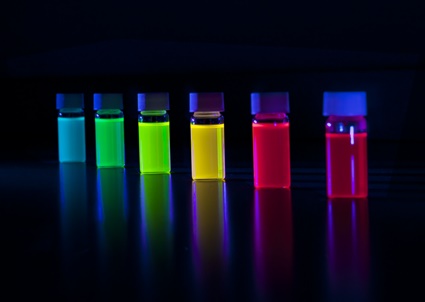How Quantum Dot Displays Are Changing the Display Market
Quantum dot displays are an emerging technology with the potential to fundamentally change the competition between LCD and OLED display technologies. It builds upon traditional LCD display systems, optimizing performance, picture quality, and energy efficiency by incorporating a layer of quantum dots into the LCD matrix.
This article will explore the current impact of quantum dots on the display market, and their potential to fundamentally change the next generation of displays.

How A Quantum Dot Display Works
LCD screens use a backlight of LEDs or a series of LEDs mounted at the edges of a screen to diffuse white light through polarizing filters, a liquid crystal layer, and a color filter, to create an image on the display surface. Essentially, the image on the screen is created by blocking and filtering wavelengths of light from reaching the display surface. This results in significant energy wastage.
Quantum dots are photo-emissive nanocrystals which are capable of naturally emitting monochromatic light when excited by an energy source. In quantum dot-enhanced LCD displays, a layer of quantum dots is overlaid on a blue LED backlight, which emits all the blue light visible onscreen while supplying the energy required for red and green quantum dots to fluoresce their respective colors. These colors can be accurately tuned by controlling the size, shape, and chemical composition of the nanocrystals, thereby precisely altering their emitted wavelengths. This results in a more vibrant display and a wider color gamut, which is a prerequisite for modern displays utilizing Ultra-HD and HDR.
Can Quantum Dot Displays Compete with OLED Displays?
OLED displays are the leading competition for LCD technology, offering technically infinite contrast ratios and thinner, lighter displays. This technology comprises of an organic, carbon-based film sandwiched between two conductors, which emits light when a current is passed through the array. The self-emissive nature of this diode makes an LED backlight redundant. It also allows for representation of true black colors on the display surface, as each individual pixel can be switched off without being affected by the backlight of neighbouring pixels. This also results in class-leading efficiency levels.
However, low manufacturing yields and expensive material costs have affected the market price of OLED displays, particularly for large panels used in modern TVs. OLED production is becoming more stable, but marketing costs remain high. Quantum dot production is similarly expensive, but recent chemical developments could result in a large-scale manufacturing breakthrough for this emergent technology.
Current generations of quantum dot-enhanced LCD displays use quantum dots based on cadmium selenide or indium phosphide chemical compositions. These materials have limited availability and exorbitantly high costs in the region of $10.000 per KG. They also require an additional inorganic shell to reach sufficient levels of quantum efficiency. To resolve this, Avantama has developed quantum dots composed of cost-efficient cesium lead halide, which require no inorganic shell and offer an absorbance per gram of at least three times higher than quantum dots of other chemical compositions. These metal halide perovskite quantum dots currently yield the highest possible quantum efficiencies, thus the best peak brightness in LCD displays.
Next Generation Quantum Dot Displays
This technology will be instrumental to the next generation of LCD screens where color filters are replaced with thermally-efficient quantum dots. As mentioned above, color filters serve the function of omitting wavelengths of light to display color. This means that a high proportion of all light produced by the display’s LEDs is wasted. Naturally produced monochromatic light from a layer of quantum dot-pixels behind a liquid crystal display layer would drastically improve energy efficiency while offering best-in class optical performance. Avantama’s quantum dot products are already suitable to produce such color filter displays.
Current quantum dot displays utilise the photo-luminescent nature of these nanocrystals to produce high purity light by stimulating them with an LED-based light source. Future iterations could revolutionize that technology by exploiting the electro-luminescent aspect of quantum dots in the manufacturing of direct-view quantum dot displays, removing the liquid crystal display entirely. This would allow for unparalleled picture quality with a wider color gamut, exceptional contrast levels, improved viewing angles, and unrivalled levels of efficiency. This array, while similar in principle to OLED technology, would vastly alter the dynamic in display technology, making it difficult for OLED to become dominant in the display market.
Quantum Dots from Avantama
Avantama has an established history in producing quantum dots for electronic applications, including for production in color filters for displays.
Our team can answer any questions you might have about our quantum dot products. Please contact us with any queries.